Статьи журнала - International Journal of Image, Graphics and Signal Processing
Все статьи: 1056
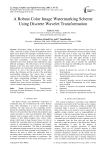
A Robust Color Image Watermarking Scheme Using Discrete Wavelet Transformation
Статья научная
Information hiding in digital media such as audio, video and or images in order to establish the owner rights and to protect the copyrights commonly known as digital watermarking has received considerable attention of researchers over last few decades and lot of work has been done accordingly. A number of schemes and algorithms have been proposed and implemented using different techniques. The effectiveness of the technique depends on the host data values chosen for information hiding and the way watermark is being embedded in them. However, in view of the threats posed by the online pirates, the robustness and the security of the underlying watermarking techniques have always been a major concern of the researchers. This paper presents a secure and robust watermarking technique for color images using Discrete Wavelet Transformation. The results obtained have shown that the technique is robust against various common image processing attacks.
Бесплатно
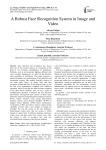
A Robust Face Recognition System in Image and Video
Статья научная
Face detection and recognition has always been one of the research interests to researchers in the field of the biometric identification of individuals. Problems such as environmental lighting, different skin color, complex background, etc affect on the detection and recognition of individuals. This paper proposes a method to enhance the performance of face detection and recognition systems. Our method, basically consists of two main parts: firstly, we detect faces and then recognize the detected faces. In the detection step, we use the skin color segmentation combined with AdaBoost algorithm, which is fast and also more accurate compared to the other known methods. Also, we use a series of morphological operators to improve the face detection performance. Recognition part consists of three steps: dimension reduction using Principal Component Analysis (PCA), feature selection using Linear Discriminant Analysis (LDA), and k-Nearest Neighbor (K-NN) or Support Vector Machine (SVM) based classification. Combination of PCA and LDA is used for improving the capability of LDA when a few samples of images are available. We test the system on the face databases. Experimental results show that the system is robust enough to detect faces in different lighting conditions, scales, poses, and skin colors from various races. Also, the system is able to recognize face with less misclassification compared to the previous methods.
Бесплатно
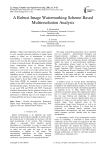
A Robust Image Watermarking Scheme Based Multiresolution Analysis
Статья научная
Digital watermarking has been widely applied to solve copyright protection problems of digital media relating to illegal use of distributions. In digital watermarking, a watermark is embedded into a cover image in such way that the resulting watermarked signal is robust to certain distortion. This paper presents a digital image watermarking based on Discrete Wavelet Transform (DWT). In the proposed method, the watermark as well as the cover image seldom looses the quality in both embedding and extraction process. The embedding process is carried out by tetra-furcating the watermark and embedded into the sub-bands of cover image. Signal to Noise Ratio (SNR) and Peak Signal to Noise Ratio (PSNR) are computed to measure image quality for the DWT transform. We present traces of host and watermarked images. From the traces we observe that, we get good SNR and PSNR with DWT. Experiment evaluation demonstrates that the proposed scheme is able to withstand a variety of attacks. This scheme shows good performance on different types of cover images in terms of imperceptibility and resist to jpeg compression.
Бесплатно
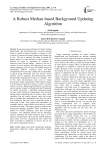
A Robust Median-based Background Updating Algorithm
Статья научная
Image processing techniques for object tracking, identification and classification have become common today as a result of improved quality of cameras as well as prices of cameras becoming cheaper and cheaper day by day. The use of cameras also make it possible for human analysis of video streams or images where it is difficult for robots or algorithms or machines to effectively deal with the images. However, the use of cameras for basic tracking and analysing do not come without challenges such as issues with sudden changes in illumination, shadows, occlusion, noise, and high computational time and space complexities of algorithms. A typical image processing task may involve several subtasks such as capturing, and pre-processing which demand high computational resources to complete. One of the main pre-processing tasks used in image processing is image segmentation which enables images to be divided into sections of interest in order to perform analysis on them. Background Subtraction is commonly used to segment images into Background and Foreground for further processing. Algorithms producing highly accurate results during this segmentation task normally demand high computation time or memory space, while algorithms that use smaller memory space and shorter time to complete this segmentation task may also suffer from limitations that may lead to undesired results at some point in time. Poor outputs from algorithms will eventually lead to system failure which must be avoided as much as possible. This paper proposes a median based background updating algorithm which determines the median of a buffer containing values that are highly correlated. The algorithm achieves this by deletingan extreme valuefrom the buffer whenever data is to be added to it.Experiments show that the method produces good results with less computational time which will make it possible to implement on devices that do not have much computation resources.
Бесплатно
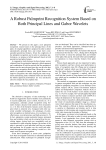
A Robust Palmprint Recognition System Based on Both Principal Lines and Gabor Wavelets
Статья научная
We present in this paper a new palmprint recognition system based on the principal lines of the palm. An original algorithm is proposed in order to detect automatically principal lines and extract their corre-spondent geometrical features. Given the complexity of the palmprint recognition and in order to ameliorate performances, we propose a hybrid approach based on both geometrical and gabor features. A comparative study between the three feature vectors obtained from the geometrical approach, global approach and combination of both has proved that the geometrical features are the most relevant since they can give the best compromise recognition Rate/Time. Moreover, a combination of geometrical features with global features can improve recognition rate while keeping the same recognition and learning times. Obtained results also show that the hybrid approach performances are very satisfactory and even surpass the very popular ones.
Бесплатно
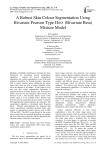
A Robust Skin Colour Segmentation Using Bivariate Pearson Type IIαα (Bivariate Beta) Mixture Model
Статья научная
Probability distributions formulate the basic framework for developing several segmentation algorithms. Among the various segmentation algorithms, skin colour segmentation is one of the most important algorithms for human computer interaction. Due to various random factors influencing the colour space, there does not exist a unique algorithm which serve the purpose of all images. In this paper a novel and new skin colour segmentation algorithms is proposed based on bivariate Pearson type II mixture model since the hue and saturation values always lies between 0 and 1. The bivariate feature vector of the human image is to be modeled with a Pearson type II mixture (bivariate Beta mixture) model. Using the EM Algorithm the model parameters are estimated. The segmentation algorithm is developed under Bayesian frame. Through experimentation the proposed skin colour segmentation algorithm performs better with respect to segmentation quality metrics such as PRI, VOI and GCE. The ROC curves plotted for the system also revealed that the proposed algorithm can segment the skin colour more effectively than the algorithm with Gaussian mixture model for some images.
Бесплатно
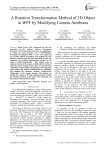
A Rotation Transformation Method of 3D Object in WPF by Modifying Camera Attributes
Статья научная
Based on the .NET Framework 2.0, the new generation of the windows software development framework .NET Framework 3.0 has four new components, in which the most attractive one is WPF(Windows Presentation Foundation). WPF is a new GUI engine that can provide uniform descriptions and methods for user interface, 2D/3D graphic, document and media. In WPF, the commonly used rotation transformation method for 3D object is RotateTransform3D. This method needs to calculate the state of the camera carefully, otherwise, the 3D object may move anomaly on the screen. To solve this kind of problem, another method is brought forward in the paper, which realizes the rotation transformation by calaulating and changing the attributes (Position, LookDirection, UpDirection) of the camera directly. The method can exhibite the rotation of 3D object distortion-freely, without the anomal movement on the screen. The calculation and the program of the method is simple.
Бесплатно
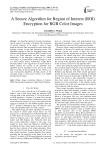
A Secure Algorithm for Region of Interest (ROI) Encryption for RGB Color Images
Статья научная
An algorithm optimized towards encrypting a specific region in an image is proposed. The encryption of specific region(s) in an image is often of more practical relevance than encrypting the entire image, thus avoiding wastage of time and processing power. The algorithm proposed is ideal for encrypting images with relatively small Region of Interest (ROI). It makes novel use of the XOR operation and the relative visual redundancy of the blue-plane components in a RGB color image. A pseudorandom number generator is used as a basic security feature. Furthermore, Cipher Block Chaining (CBC) is also suggested as an improvement to further enhance the security of the algorithm. The algorithm may be classified as lossy since some visual data is sacrificed in the decrypting process. However, in case of encryption algorithms, the high security of the encrypted image is often given priority over faithful reproduction of images.
Бесплатно
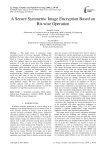
A Secure Symmetric Image Encryption Based on Bit-wise Operation
Статья научная
This paper shows a symmetric image encryption based on bit-wise operation (XORing and Shifting). The basic idea is block ciphering (size of each block is 4 bytes) technique to cipher the secret bytes, after that ciphered bytes are again shuffled among N positions (N is the size of secret file). The scheme is combination of substitution as well as transposition techniques which provides additional protection of the secret data. The substitution and transposition are done using dynamic substitution box (SBOX) and transposition box (TBOX) which are generated using the secret key and made to vary for each block during ciphering. The size of encrypted data is same as the size of secret data and the proposed scheme has been tested using different images. We have also presented the security analysis such as key sensitivity analysis, statistical analysis, and differential analysis to prove the strength of our algorithm against crypto analysis.
Бесплатно
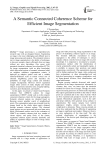
A Semantic Connected Coherence Scheme for Efficient Image Segmentation
Статья научная
Image processing is a comprehensively research topic with an elongated history. Segmenting an image is the most challenging and difficult task in image processing and analysis. The principal intricacy met in image segmentation is the ability of techniques to discover semantic objects efficiently from an image without any prior knowledge. One recent work presented connected coherence tree algorithm (CCTA) for image segmentation (with no prior knowledge) which discovered regions of semantic coherence based on neighbor coherence segmentation criteria. It deployed an adaptive spatial scale and a suitable intensity-difference scale to extract several sets of coherent neighboring pixels and maximize the probability of single image content and minimize complex backgrounds. However CCTA segmented images either consists of small, lengthy and slender objects or rigorously ruined by noise, irregular lighting, occlusion, poor illumination, and shadow. In this paper, we present a Cluster based Semantic Coherent Tree (CBSCT) scheme for image segmentation. CBSCT's initial work is on the semantic connected coherence criteria for the image segregation. Semantic coherent regions are clustered based on Bayesian nearest neighbor search of neighborhood pixels. The segmentation regions are extracted from the images based on the cluster object purity obtained through semantic coherent regions. The clustered image regions are post processed with non linear noise filters. Performance metrics used in the evaluation of CBSCT are semantic coherent pixel size, number of cluster objects, and purity levels of the cluster, segmented coherent region intensity threshold, and quality of segmented images in terms of image clarity with PSNR.
Бесплатно
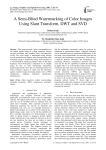
A Semi-Blind Watermarking of Color Images Using Slant Transform, DWT and SVD
Статья научная
This paper presents a robust watermarking for still digital images based on a Slant transform, discrete wavelet transforms and Singular Value Decomposition (SVD). The cover image is transformed using discrete wavelet transform and singular value decomposition while watermark image is transformed using slant transform. It is watermarked by replacing singular values of the high-frequency and low-frequency component of an original image by that of slant transformed watermarks. Experimental results show that our method guarantees the robust resistance against no attack and the robustness against common image processing attacks such as JPEG compression, cropping, histogram equalization, sharpening etc.
Бесплатно
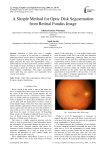
A Simple Method for Optic Disk Segmentation from Retinal Fundus Image
Статья научная
Detection of optic disc area is complex because it is located in an area that is considered as pathological blood vessels when in segmentation and thus require a method to detect the area of the optic disc, this paper proposed the optic disc segmentation using a method that has not been used before, and this method is very simple, K-means clustering is a proposed Method in this paper to detect the optic disc area with perfected using adaptive morphology. This paper successfully detect optic disc area quickly and segmented blood vessels more quickly.
Бесплатно
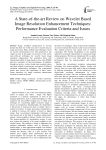
Статья научная
Image resolution enhancement in wavelet domain has been one of the most active research areas in image processing. Many methods and techniques, based on wavelet transformation have been proposed in last couple of years. In this paper, we present a review on the state-of-the-art techniques for wavelet based image resolution enhancement. We summarize them with enhancement ability in peak signal to noise ratio (PSNR) and give comments on their performance. In addition, through our review, we have found some essential criteria and issues related to performance assessment of different resolution enhancement techniques. Our experimental results have proved the significance of these issues. Future directions for image resolution enhancement research are stated at the end.
Бесплатно
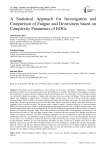
Статья научная
The primary factors contributing to road accidents are drowsiness and fatigue. Additionally, it diminishes productivity within work environments and elevates the likelihood of accidents. The analysis of bio-signals is crucial in the examination of various physical conditions and the physiological state of an individual. Various biological signals were utilized to identify the presence of fatigue and drowsiness that is associated with fatigue. Various physiological signals were employed to identify driver or operator fatigue and drowsiness. Out of all these non-invasive signals, electrooculogram (EOG) exhibits well-accepted outcomes for detecting drowsiness and fatigue. By employing an EOG-based study, the real-time monitoring of the muscle and mental fatigue of the human subject can be done when they are engaging in their everyday activities. The present studies sought to employ a statistical analysis of electrooculograms (EOGs) to ascertain the stress levels of participants and provide insight into their state of fatigue and drowsiness. Two different experimental studies were performed with 120 and 80 healthy male and female research scholars of National Institute of Technology Durgapur, India. EOGs were recorded by the Biopac MP 45 data acquisition system at two and three different sessions of a day with huge cognitive tasks in between. Several entropies are evaluated from the time domain and frequency domain. The others complexity parameters are also incorporated to enrich the results of the experimental processes. An inferential statistical analysis based on the parametric t-test and non-parametric Wilcoxon test for study-I was considered to compare the stress levels between morning and evening sessions. Similarly, in study-II, the parametric ANOVA test and non-parametric Friedman test were carried out to monitor stress level in three different sessions of a day. The Tukey-Kramer post-hoc test is also undertaken to compare the outcomes among three different sessions and find the statistical differences based on a 5% significance level. Most complexity parameters show excellent results and clear differences in fatigue states for both the experiments and these analyses indicates the presence of onset fatigue among the subjects under consideration.
Бесплатно
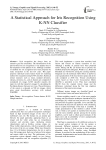
A Statistical Approach for Iris Recognition Using K-NN Classifier
Статья научная
Irish recognition has always been an attractive goal for researchers. The identification of the person based on iris recognition is very popular due to the uniqueness of the pattern of iris. Although a number of methods for iris recognition have been proposed by many researchers in the last few years. This paper proposes statistical texture feature based iris matching method for recognition using K-NN classifier. Statistical texture measures such as mean, standard deviation, entropy, skewness etc., and six features are computed of normalized iris image. K-NN classifier matches the input iris with the trained iris images by calculating the Euclidean distance between two irises. The performance of the system is evaluated on 500 iris images, which gives good classification accuracy with reduced FAR/FRR.
Бесплатно
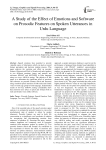
Статья научная
Speech emotions have potential to provide valuable source of information which can lead us toward human perception and decision making process. This paper analyzes the variation and effect on prosodic features (Formant and Pitch) of female and male speakers in two different emotions (angry and neutral) and softwares (PRAAT and MATLAB) in Urdu language using two ways ANOVA testing. The objective of this paper is to determine the significant effect of emotions and softwares on prosodic features (Pitch and Formant) using recorded speech emotion of both male and female voices of same age group in Urdu language. Experimental results of two-way ANOVA testing considerably show that emotions have effect on pitch and formant both in male and female voice unlike software.
Бесплатно
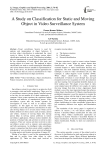
A Study on Classification for Static and Moving Object in Video Surveillance System
Статья научная
Visual surveillance System is used for analysis and interpretation of object behaviors. It involves object classification to understand the visual events in videos. In this review paper various object classification methods are used. Classification technique plays an important role in surveillance system that is used for the classification of both objects like static and moving objects in a better way. The methods in object classification are used to extract meaningful information and various features that are needed for representation of data. In this survey, we described various approaches for moving objects that are used in classification for video surveillance system based on shape and motion.
Бесплатно
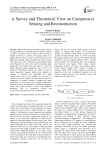
A Survey and Theoretical View on Compressive Sensing and Reconstruction
Статья научная
Most of the current embedded systems operate on digital domain even though input and output is analog in nature. All these devices contain ADC (Analog to Digital converter) to convert the analog signal in to digital domain which is used for processing as per the application. Images, videos and other data can be exactly recovered from a set of uniformly spaced samples taken at the Nyquist rate. Due to the recent technology signal bandwidth is becoming wider and wider. To meet the higher demand, signal acquisition system need to be improved. Traditional Nyquist rate which is used in signal acquisition suggests taking more numbers of samples to increase the bandwidth but while reconstruction most of the samples are not used. If samples are as per Nyquist rate then, this increases the complexity of encoder, storage of samples and signal processing. To avoid this new concept Compressive Sensing is used as an alternative for traditional sampling theory. This paper presents a survey and simplified theoretical view on compressive sensing and reconstruction and proposed work is introduced.
Бесплатно
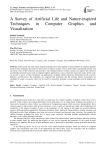
A Survey of Artificial Life and Nature-inspired Techniques in Computer Graphics and Visualization
Статья научная
Artificial life and other nature-inspired techniques have been applied to many problems in computer graphics. Some of these techniques are based on observations of organic systems, such as slime molds and flocking animals, and can mimic some of their behaviors and structures. The emergent behavior of these systems can improve the realism of procedurally-generated assets used in computer graphics applications, such as animation and texture maps. In this work, we provide a survey of these techniques and applications, including cellular automata, differential growth, reaction-diffusion, and Physarum. The techniques are compared and contrasted, and the common themes and patterns are elucidated to create a taxonomy which can be useful to researchers studying existing techniques and developing new ones.
Бесплатно
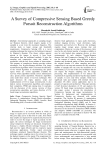
A Survey of Compressive Sensing Based Greedy Pursuit Reconstruction Algorithms
Статья научная
Conventional approaches to sampling images use Shannon theorem, which requires signals to be sampled at a rate twice the maximum frequency. This criterion leads to larger storage and bandwidth requirements. Compressive Sensing (CS) is a novel sampling technique that removes the bottleneck imposed by Shannon's theorem. This theory utilizes sparsity present in the images to recover it from fewer observations than the traditional methods. It joins the sampling and compression steps and enables to reconstruct with the only fewer number of observations. This property of compressive Sensing provides evident advantages over Nyquist-Shannon theorem. The image reconstruction algorithms with CS increase the efficiency of the overall algorithm in reconstructing the sparse signal. There are various algorithms available for recovery. These algorithms include convex minimization class, greedy pursuit algorithms. Numerous algorithms come under these classes of recovery techniques. This paper discusses the origin, purpose, scope and implementation of CS in image reconstruction. It also depicts various reconstruction algorithms and compares their complexity, PSNR and running time. It concludes with the discussion of the various versions of these reconstruction algorithms and future direction of CS-based image reconstruction algorithms.
Бесплатно

